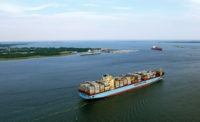Driving legislation through the hotly partisan 114th Congress was a struggle, so it’s no surprise that construction and water industry officials are happy to see one big infrastructure bill make it to the finish line—the Water Infrastructure Improvements for the Nation Act. But it will be a long time before the WIIN Act’s projects get construction funding.
Much of industry’s focus in the new law, enacted on Dec. 16, is on the its Water Resources Development Act (WRDA) title, which authorizes $10.3 billion in federal funds for 30 new Army Corps of Engineers projects. Nonfederal agencies also will help finance many of those projects.
Local backers of the projects—and their House and Senate advocates—pushed to get them included in the bill, knowing that an authorization is a necessary step.
But for most of those projects, construction starts are years away, mainly because the projects now have to batlle for actual appropriations before contracts can be awarded. For one thing, domestic nondefense budgets have been persistently tight. Uncertainty about what the incoming Trump administration will recommend for the Corps’ fiscal 2018 civil-works budget makes the outlook even murkier.
John Doyle, special counsel with law and lobbying firm Jones Walker LLP, says that getting Corps projects authorized is “a major milestone, to be sure, but by no means [indicates] that the project is ready to go to construction the next day, or is even close to it.”
The first appropriations hurdle is getting money for detailed preliminary engineering and design. Doyle, a former top Army civil-works official, says that completing design work and moving to the construction phase usually “takes two, and sometimes three, years.” He adds, “And it could—depending on the nature of the project—be even longer than that.”
Three port projects contained in the last water-resources measure, enacted in 2014 —Charleston, Port Everglades, Fla., and Boston harbor—already have a leg up, receiving engineering money in the Corps’ 2016 work plan.
Jim Walker, American Association of Port Authorities director of navigation policy and legislation, notes that others from 2014 are still waiting for the federal design dollars. Most of the six port projects in the 2016 WRDA now join the list.
“They’re all kind of at the starting gate…looking to get that preliminary engineering and design money,” says Walker, who also is a former Corps civil-works official.
What will the legislative vehicle be for the engineering and design funds? The Corps civil-works program has enjoyed bipartisan support on Capitol Hill. But Doyle says the likelihood “is probably pretty low” that all the 2016 WRDA projects will get engineering funds in the 2017 spending package that succeeds the recently enacted stopgap continuing resolution. The CR expires on April 28.
Another possibility is the appropriations measure for fiscal 2018, which begins on Oct. 1, 2017.
An important signal will come in the Trump administration’s FY 2018 budget proposal, expected to be released sometime early next year. How much Trump’s team will recommend for the Corps, or any other construction program, is unknown.
But going back at least to the George W. Bush administration, the Office of Management and Budget has set a high hurdle before new Corps projects can be included in the annual presidential budget blueprint. OMB’s cost-benefit threshold for such projects is much tougher than the one the Army Chief of Engineers uses in his authorization reports, Doyle observes. A positive “Chief’s report” gives a project a ticket into a WRDA bill.
Still, the WIIN Act and its WRDA section represent a victory for construction and water groups. If the 114th Congress had failed to pass a water-resources bill before it adjourned, the 115th Congress would have had to start from scratch on a new measure. That would have made the waiting time for engineering and construction funds that much longer.



Post a comment to this article
Report Abusive Comment